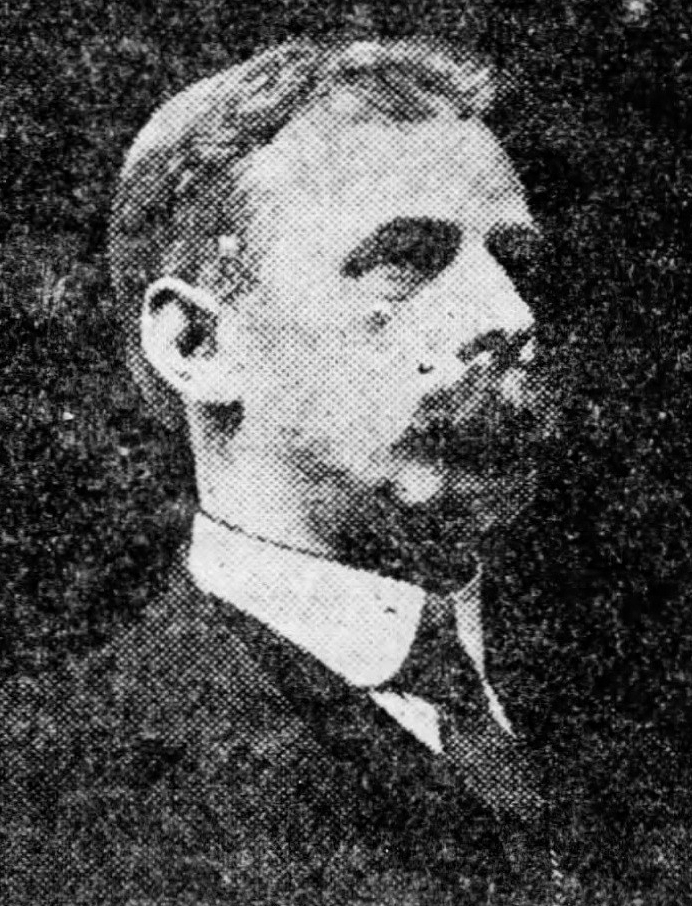Joseph Foster Stackhouse: He was born 10 August 1873 in Kendal, Westmoreland, England, to Thomas Petchell, a manufacturer agent and commercial traveller in the wool business born 1846 in New Malton, Yorkshire, and Martha (nee Bowden; she was born ca. 1848 in Liskeard, Cornwall) Stackhouse, who had married toward the end of 1870 in Edmonton, England. He had two known brothers, Thomas Petchell, b. ca. 1875 in Kendal, and Frederick Norman, b. ca. 1883 in Bradford, Yorkshire (he was later a woollen manufacturer’s agent). In 1881, the Stackhouse family lived at Castle Park Terrace in Kendal. Papa Stackhouse was noted as a commercial traveller for a woollen manufacturer and there was a general domestic servant in the household, Isabella Raven, aged 22. In 1891, J. F. Stackhouse was described as an apprentic draper living in Scarborough, Yorkshire. He married Florence Richardson Hutchinson 17 July 1900 at the Friends’ Meeting House, Wellingborough, Northamptonshire. After their wedding they went on a honeymoon trip to Devonshire and then they took up residence at Roker, Sunderland. They had a daughter, Elizabeth Petchell Stackhouse, b. ca. 1903. In 1901, he was listed as ”John F. Stackhouse,” a district advertising agent for the N E Railway, living in Park Lea Road in Sunderland, Durham, England. In 1911 he lived in Saltburn by the Sea, Yorkshire, still an advertising agent for the South Eastern Railway. His first journey to the USA took place in 1903 when he was travelling on the Cestrian and was bound for the Boston Institute of Tecnology. He was described as an advertising agent. at the time. He must have switched careers at some point after 1911, since he was described as a British explorer in 1915. He was going to be the leader of an expedition to the Antarctica in 1914, which included researchers from South Africa, New Zealand, Canada and Australia. The expedition was to be a prolonged scientific and geographical survey. They had purchased Captain Scott’s old ship Discovery and a Lieutenant Harboard had been appointed commander of the ship. Mr. Stackhouse’s (Mrs. Stackhouse’s?) uncle, Sir Jonathan Hutchinson, into the Hutchinson was the organiser of the British Antarctic Exhibition in 1914, and Mr. Hutchinson’s research is said to have sparked Mr. Stackhouse’s interest in researching the Antarctica. Mr. Stackhouse was also said to have been an architect, albeit there is no evidence to support this, what with Mr. Stackhouse being a draper/advertising agent. He had come to the USA on the s.s. Franconia 30 August 1914, bound for the Hydrographical Society in Washington, D. C. He was 5’11’’ tall, had grey hair and dark eyes. While he was in America raising funds on behalf of the British Antarctic and Oceanographical Expedition, Mrs. Stackhouse and their daughter lived with her parents at Broughton. The expedition would have left England in late 1914 but was postponed because of the war. ’Dr. Pearson, a well-known American engineer, also one of the Lusitania’s passengers, was associated with Commander Stackhouse as one of the backers of the expedition. Dr. Pearson, who was accompanied by his wife, for a visit to England, was interested largely in Mexican railways. Commander J. Foster Stackhouse, head of the proposed British Antarctic Oceanographical Society, which contemplated a seven year trip to chart the Southern Seas. Commander Stackhouse came over here last summer to seek the assistance of Americans in the enterprise and purchased the exploring ship Discovery for the purpose. The fruition of the expedition was delayed by the war.’’ (Harrisburg Daily Independent, 8 May 1915, p. 1) Commander Stackhouse did not survive the sinking of the Lusitania. His body was recovered and identified after the sinking (No. 211). He was buried, by relatives, at Cork on 17 May. His property was forwarded to his widow, Mrs. F. Stackhouse, Wythemagh, Broughton, Kettering, June 4th. In his will, he left £562 10s. to his widow. Notte: there is no evidence as yet to the effect that ”Commander” was a military title. It could be that since he was to be in charge of the abovementioned expedition, he was mentioned as ”commander” as in ”commander of the expedition.” The material presented on this page has been researched by Peter Engberg-Klarström. Copyright 2017 Peter Engberg-Klarström. Feel free to use the research, but please refer to my research if used in publications or if published or posted on other pages on the Internet.

The Washington Herald 10 May 1915, p. 10
